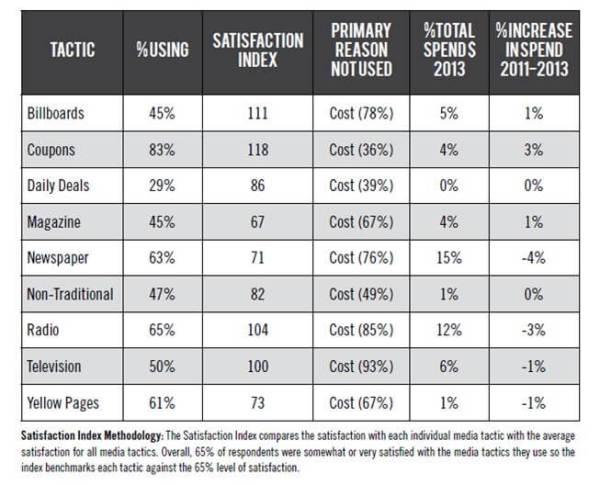newspapers
In a new study by Brandmuscle, hundreds of local dealers, agents and franchisees across a wide range of industries indicated that “traditional media (newspapers, magazines, radio, television, yellow pages, coupons and billboards) continue to play a significant role in local marketing.”
Respondents rated their level of satisfaction with a variety of traditional marketing tactics. Surprisingly, they chose coupons as having the greatest satisfaction, with newspapers having the least. Coupons performed well in terms of overall satisfaction and were the most widely used tactic with 83% of respondents using them and 77% of those saying they were either somewhat or very satisfied with the results.
Interesting that daily deals like Groupon, had just 29% of respondents using them and nearly one in four stating they were “least satisfied” with the results. Daily deals also topped the list of tactics that affiliates felt were “too risky” (14%).

Other Data to Note:
 If you’re targeting high-income Baby Boomers with your marketing, you’ve got to see this new research from the Luxury Institute. It surveyed consumers 21 and older from U.S. households with annual income of at least $150,000 about the types of media that they consume and the time they spend on each.
If you’re targeting high-income Baby Boomers with your marketing, you’ve got to see this new research from the Luxury Institute. It surveyed consumers 21 and older from U.S. households with annual income of at least $150,000 about the types of media that they consume and the time they spend on each.
Affluent Baby Boomers are spending almost twice as much time with print and TV than their Millennial counterparts, while lagging in their usage of social media, online radio and online video. Not surprised? There’s more. Continue reading
Of all the ways you thought your prospects could find your business or nonprofit organization online, which of the following do you think is number one?
- Social networks
- Links in e-mails
- Search engines
- QR codes in print media
So, which one did you choose?
Well, according to Forrester Research and MarketingCharts, “online adults in the U.S. are more likely to discover websites via natural search engine results than any other means.” Surprised?
Respondents were asked how they typically found websites they had visited in the prior month, with 54% pointing to search, up from 50% the prior year. Notably, social networking sites moved up a couple of notches to the second spot in the website discovery rankings, typically used by 32% in 2012, up from 25% in 2011.”
One important takeaway from this study.
Don’t give up on e-mail marketing. In 2012, 26% of respondents said that they typically found websites as a result of emails from companies or brands, up from 15% the year before.
Other findings:
- Paid search results were cited by 18% of respondents, a big increase from 8% the year before.
- Offline sources had a role too: newspapers/magazine articles (18%) and TV shows or news stories (15%) were used by some.
Which method do YOU use to find Web sites?
